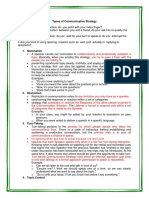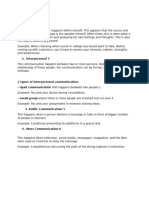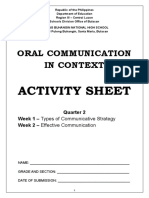Lesson 8 Oral Com
Uploaded by
Eunice C. LoyolaLesson 8 Oral Com
Uploaded by
Eunice C. LoyolaTHE DIFFERENT SPEECH STYLES Speech Acts:
1. Frozen Speech act theory broadly explains these utterances:
It is the most formal communicative style that is usually
used during respectful events and ceremonies. It also 1 .Locutionary act :saying something (the locution)
used when one shows hesitation, disinterest or prejudice.
with a certain meaning in traditional sensecomprise
Frozen speech is used generally in a very formal setting,
simply the speech acts that have taken place.Two
does not require any feedback from the audience, most
formal communicative style for respectful situations. types of locutionary act :
EXAMPLE: Pledges, anthems, marriage ceremonies, utterance acts: where something is said (or a sound
laws, etc. is made) and which may not have any meaning ,
2. Intimate example: Oh! -is an utterance (communication is not
For very close relationships like couples, family, and best intended -it is just a sound caused by surprise .)
friends. It is also used for self-addressed questions or
self-talk, etc. Intimate speech is used in conversation
propositional acts: where a particular reference is
between people who are very close and know each other
quite well because they have the maximum of shared made
background information.
Example: ”The black cat ” (something is referenced,
EXAMPLES: Couple talking about their future plans, but no communication may be intended
family sharing ideas, very close friends sharing
secrets, etc. 2.llocutionary acts: are the real actions which are
performed by the utterance, where saying equals
3. Formal doing, as in betting, believe , dare, warning.etc .
Formal speeches are straightforward speeches. In this
speech style, the speaker avoids using slang terminologies,
Example:”I promise to pay you back”-is an
what the speaker says is something that has been
prepared beforehand, its complex sentence and noun illocutionary act (it intends to communicate..)The
phrases are well structured, logically sequenced and illocutionary force is the speaker's intent. A true
strongly coherent. 'speech act .'e.g. informing, ordering, warning,
undertaking.
EXAMPLES: Announcements, SONA, welcome
addresses, etc. 3.Perlocutionary acts: Speech acts that have an
effect on the feelings, thoughts or actions of either
4. Casual
the speaker or the listener. In other words, they
This is an informal communication between groups and
seek to change minds
peers. Casual style is used in conversation between
friends and insiders who have something to share and
have shared background information but don’t have close Example: “Please find the black cat ”-is a directive
relations. perlocutionary act (it seeks to change behaviour).
EXAMPLES: phone calls, everyday conversation with
friends, chats, etc.
5. Consultative
This is used in semi-formal communication, sentences end
to be shorter and spontaneous, the speaker does not
usually plan what he/she wants to say, most operational
among others.
EXAMPLES: regular classroom discussions, doctor-
patient, etc.
o "Go on with your ideas. I'll let you finish
Types of Communicative Strategy first before I say something."
1. Nomination
A speaker carries out nomination to 4. Topic Control
collaboratively and productively establish a Topic control covers how procedural
topic. Basically, when you employ this formality and informality affects the
strategy, you try to open a topic with the development of topics in conversation. This
people you are talking to. only means that when a topic is initiated, it
presenting a particular topic clearly, should be collectively developed by
truthfully, and saying only what is relevant avoiding unnecessary interruptions and
topic shifts.
It is a strategy that can also be applied any
time during the course of an interaction as keeping the interaction going by asking
a way of continuing the communication. questions and eliciting a response
When this strategy is used, the topic is This is simply a question-answer formula
introduced in a clear and truthful manner, that moves the discussion forward. This
stating only what is relevant to keep the also allows the Listener or other
interaction focused. participants to take turns, contribute ideas,
Examples: and continue the discussion.
o "Do you have anything to say?" Example:
o "Have you heard the news about the o "One of the essential lessons I gained
prettiest girl in school?" from the discussion is the importance
o "Now, it’s your turn to ask questions." of sports and wellness to a healthy
lifestyle."
o "Does that make sense to you?"
5. Topic Shifting
2. Restriction
Topic shifting, as the name suggests,
Restriction in communication refers to any
involves moving from one topic to another.
limitation you may have as a speaker.
In other words, it is where one part of a
constraining the response or reaction conversation ends and where begins.
within a set of categories introducing a new topic followed by the
strategy that constrains or restricts the continuation of that topic
Response of the other person involved in strategy that is useful in introducing
the Communication Situation. The Listener
another topic. This strategy works best
is forced to respond only within a set of
when there is follow-through so that new
categories that is made by the Speaker.
topic continues to be discussed.
Examples:
Examples:
o In your class, you might be asked by
o "By the way, there's a new shop
your teacher to brainstorm on peer
opening at the mall"
pressure.
o “In addition to what you said about the
o When you were asked to deliver a
beautiful girl is that she is also smart."
speech in a specific language.
6. Repair
3. Turn-Taking
Repair refers to how speaker address the
Turn-taking pertains to the process by
problems in speaking, listening, and
which people decide who takes the
comprehending that they may encounter in
conversational floor. There is a code of
a conversation.
behaviour behind establishing and
overcoming communication breakdown to
sustaining a productive conversation, but
send more comprehensible messages
the primary idea is to give all
Examples:
communicators a chance to speak.
o "Excuse me, but there are 5 Functions
recognizing when and how to speak
of Communication not 4."
because it is one’s turn
o "I'm sorry, the word should be
requires that each Speaker speaks only
pronounced as pretty not priti."
when it is his/ her turn during interaction.
7. Termination
Knowing when to talk depends on watching
out for the verbal and nonverbal cues that Termination refers to the conversation
signal the next Speaker that the previous participants’ close-initiating expressions
Speaker has finished or the topic under that end a topic in a conversation.
discussion has been exhausted and a new using verbal and nonverbal signals to end
topic may be introduced. At the same time, the interaction
it also means that others should be given ends the interaction through verbal and
the opportunity to take turn. Turn-taking nonverbal Messages that both Speaker
Communicative Strategy uses either an and Listener send to each other.
informal approach (just jump in and start Sometimes the Termination is quick and
talking) or a formal approach (permission short. Sometimes it is prolonged by
to speak is requested). clarification, further questions, or the
Example: continuation of the topic already discussed,
o Can we all listen to the one who talk in but the point of the language and body
front of us? movement is to end the communication.
o "Excuse me? I think we should speak Examples:
one at a time, so we can clearly o "Best regards to your parents! See you
understand what we want to say about around!
the topic." o “It was nice meeting you. Bye!"
o "That is all for today class, goodbye!"
You might also like
- Foreign Exchange Options and Risk Management - Market Dynamics, Models and Human BehaviourNo ratings yetForeign Exchange Options and Risk Management - Market Dynamics, Models and Human Behaviour408 pages
- BIAS AMP Models and Modeling References PDFNo ratings yetBIAS AMP Models and Modeling References PDF4 pages
- Communicative Strategies Are Techniques On How To Deal With Difficulties Encountered When CommunicatingNo ratings yetCommunicative Strategies Are Techniques On How To Deal With Difficulties Encountered When Communicating5 pages
- Rogationist College Senior High School Department School Year 2017-2018No ratings yetRogationist College Senior High School Department School Year 2017-20184 pages
- Oral Communication in Context: Quarter 2 - Module 3No ratings yetOral Communication in Context: Quarter 2 - Module 312 pages
- Types of Communicative Strategy: Lesson 1No ratings yetTypes of Communicative Strategy: Lesson 125 pages
- Reviewer On Oral Communication For 2nd Quarter100% (1)Reviewer On Oral Communication For 2nd Quarter10 pages
- Rogationist College Senior High School Department School Year 2017-2018No ratings yetRogationist College Senior High School Department School Year 2017-20184 pages
- Reviewer On Oral Communication For 2nd QuarterNo ratings yetReviewer On Oral Communication For 2nd Quarter12 pages
- Q1 Module 7 - Topic7 - Communicative Strategy100% (1)Q1 Module 7 - Topic7 - Communicative Strategy7 pages
- Types of Communicative Strategy 1. NominationNo ratings yetTypes of Communicative Strategy 1. Nomination3 pages
- Second Quarter Oral Com Topics For StudentsNo ratings yetSecond Quarter Oral Com Topics For Students11 pages
- 2ND Quarter Module Oral Communication 11No ratings yet2ND Quarter Module Oral Communication 1165 pages
- q1 Module 7 - Topic7 - Communicative StrategyNo ratings yetq1 Module 7 - Topic7 - Communicative Strategy5 pages
- Strategies in Various Speech Situations: Intrapersonal CommunicationNo ratings yetStrategies in Various Speech Situations: Intrapersonal Communication5 pages
- Oral Communication in Context: Self-Learning ModulesNo ratings yetOral Communication in Context: Self-Learning Modules12 pages
- Module 6 Types of Communicative Strategies 1No ratings yetModule 6 Types of Communicative Strategies 17 pages
- Types of Communicative Strategy: Prepared By:david Jhonson M. Basnillo and John Marco Y. Sarol Grade Xi - Stem 2 StudentsNo ratings yetTypes of Communicative Strategy: Prepared By:david Jhonson M. Basnillo and John Marco Y. Sarol Grade Xi - Stem 2 Students10 pages
- Reminders: Maximum of 3-5 Sentences Only! Do Not Copy Paste Your Answers in The Internet. Observe The Rubric Below For Your Content ReferenceNo ratings yetReminders: Maximum of 3-5 Sentences Only! Do Not Copy Paste Your Answers in The Internet. Observe The Rubric Below For Your Content Reference1 page
- ACFrOgAibO64MbawrTegV97a2iu8883g6Xv9 L9at-KjygJ1r 0ZNf33It9QWyQl5UmJ0U-8wLdf3YxKBqogsUacDxb7NucGUm 0-LI2TEeYD8wS59H1jEM 1JRtjMl1bFgXxBDxSG2KoULbTV1INo ratings yetACFrOgAibO64MbawrTegV97a2iu8883g6Xv9 L9at-KjygJ1r 0ZNf33It9QWyQl5UmJ0U-8wLdf3YxKBqogsUacDxb7NucGUm 0-LI2TEeYD8wS59H1jEM 1JRtjMl1bFgXxBDxSG2KoULbTV1I42 pages
- Banner Advertisement of A Responsible AdolescentNo ratings yetBanner Advertisement of A Responsible Adolescent1 page
- Disaster Readiness and Risk Reduction Script: Ppt-Advertisment 11-STEM 6 Sacred Heart CollegeNo ratings yetDisaster Readiness and Risk Reduction Script: Ppt-Advertisment 11-STEM 6 Sacred Heart College8 pages
- English A2.2 PCA - PUD 1ro BachilleratoNo ratings yetEnglish A2.2 PCA - PUD 1ro Bachillerato25 pages
- The Common Temple Ideology of The Ancient Near EastNo ratings yetThe Common Temple Ideology of The Ancient Near East22 pages
- Budapest Ceenet 2001 - Satellite CommunicationsNo ratings yetBudapest Ceenet 2001 - Satellite Communications93 pages
- Rizal University of Santo Tomas (1877-1882)No ratings yetRizal University of Santo Tomas (1877-1882)20 pages
- TLE GRADE 7 4TH QUARTER INDUSTRIAL ARTS - TOPIC 1234No ratings yetTLE GRADE 7 4TH QUARTER INDUSTRIAL ARTS - TOPIC 12343 pages



































































































